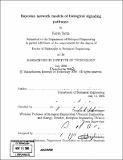| dc.contributor.advisor | Douglas A. Lauffenburger. | en_US |
| dc.contributor.author | Sachs, Karen, Ph. D. Massachusetts Institute of Technology | en_US |
| dc.contributor.other | Massachusetts Institute of Technology. Biological Engineering Division. | en_US |
| dc.date.accessioned | 2007-08-30T15:26:21Z | |
| dc.date.available | 2007-08-30T15:26:21Z | |
| dc.date.copyright | 2006 | en_US |
| dc.date.issued | 2006 | en_US |
| dc.identifier.uri | http://hdl.handle.net/1721.1/38865 | |
| dc.description | Thesis (Ph. D.)--Massachusetts Institute of Technology, Biological Engineering Division, 2006. | en_US |
| dc.description | Includes bibliographical references (p. 153-165). | en_US |
| dc.description.abstract | Cells communicate with other cells, and process cues from their environment, via signaling pathways, in which extracellular cues trigger a cascade of information flow, causing signaling molecules to become chemically, physically or locationally modified, gain new functional capabilities, and affect subsequent molecules in the cascade, culminating in a phenotypic cellular response. Mapping the influence connections among biomolecules in a signaling cascade aids in understanding of the underlying biological process and in development of therapeutics for diseases involving aberrant pathways, such as cancer and autoimmune disease. In this thesis, we present an approach for automatically reverse-engineering the structure of a signaling pathway, from high-throughput data. We apply Bayesian network structure inference to signaling protein measurements performed in thousands of single cells, using a machine called a flow cytorneter. Our de novo reconstruction of a T-cell signaling map was highly accurate, closely reproducing the known pathway structure, and accurately predicted novel pathway connections. The flow cytometry measurements include specific perturbations of signaling molecules, aiding in a causal interpretation of the Bayesian network graph structure. | en_US |
| dc.description.abstract | (cont.) However, this machine can measure only -4-12 molecules per cell, too few for effective coverage of a signaling pathway. To address this problem, we employ a number of biologically motivated assumptions to extend our technique to scale up from the number of molecules measured to larger models, using measurements of overlapping variable subsets. We demonstrate this approach by scaling up to a model of 11 variables, using 15 overlapping 4-variable measurements. | en_US |
| dc.description.statementofresponsibility | by Karen Sachs. | en_US |
| dc.format.extent | 165 p. | en_US |
| dc.language.iso | eng | en_US |
| dc.publisher | Massachusetts Institute of Technology | en_US |
| dc.rights | MIT theses are protected by copyright. They may be viewed, downloaded, or printed from this source but further reproduction or distribution in any format is prohibited without written permission. | en_US |
| dc.rights.uri | http://dspace.mit.edu/handle/1721.1/7582 | |
| dc.subject | Biological Engineering Division. | en_US |
| dc.title | Bayesian network models of biological signaling pathways | en_US |
| dc.type | Thesis | en_US |
| dc.description.degree | Ph.D. | en_US |
| dc.contributor.department | Massachusetts Institute of Technology. Department of Biological Engineering | |
| dc.identifier.oclc | 146356491 | en_US |
